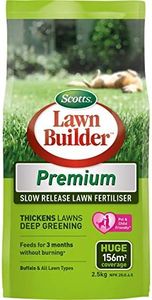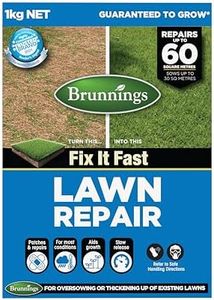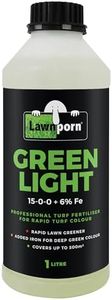We Use CookiesWe use cookies to enhance the security, performance,
functionality and for analytical and promotional activities. By continuing to browse this site you
are agreeing to our privacy policy
5 Best Topsoil For Lawns
From leading brands and best sellers available on the web.Buying Guide for the Best Topsoil For Lawns
Choosing the right topsoil for your lawn is essential for building strong, healthy grass. The right topsoil will give your lawn the nutrients, texture, and drainage it needs to flourish. When selecting topsoil, you’ll want to pay attention to the specific qualities that impact plant growth, such as soil composition, organic matter, texture, and pH level. Understanding these will help you match your soil to your lawn’s specific requirements and local conditions, resulting in greener, fuller grass.Soil CompositionSoil composition refers to the blend of sand, silt, and clay that makes up the soil. This affects water retention, drainage, and root growth. A lawn thrives best on loamy soil, which has balanced sand, silt, and clay. Sandy soils drain quickly but don’t hold nutrients, clay soils retain water but can get compacted, and silt is somewhere in between. Choose a loamy composition for most lawns, but if your area has heavy rain, you might want a slightly sandier mix for better drainage. Conversely, in drier places, a bit more clay can help retain moisture.
Organic Matter ContentOrganic matter is the amount of decomposed plant or animal material in the soil. It improves soil fertility, structure, and water-holding ability. Higher organic matter is generally better, as it supports microbial life and makes nutrients available to grass. If you’re starting a new lawn or repairing poor soil, opt for richer organic content. For established lawns, a moderate amount is sufficient to maintain health without overwhelming the grass roots.
Texture and Particle SizeTexture describes how fine or coarse the soil feels, which relates to particle size. Fine soils can become compacted and block air and water flow, while coarse soils may drain too quickly. Lawn topsoil should be crumbly and easily broken apart in your hand, often described as ‘friable’. For heavy clay regions, a coarser, open texture is beneficial for drainage, while in sandy locations, a finer texture helps retain moisture. Always check the texture by feeling a sample—aim for a balanced, crumbly feel.
pH LevelThe pH measures how acidic or alkaline the soil is. Most lawn grass prefers a neutral to slightly acidic pH (around 6.0 to 7.0). If soil is too acidic or alkaline, grass can struggle to absorb nutrients. To find the right match, consider testing your current soil or asking for the pH of the topsoil you’re buying. Use a topsoil close to neutral pH if you’re unsure, but if your local water or soil is known to be acidic or alkaline, match accordingly.
Cleanliness and PurityCleanliness means the absence of weed seeds, debris, and contaminants in the topsoil. Poor-quality topsoil may contain sticks, stones, trash, or invasive plant seeds. This is important because contaminants can affect lawn health and lead to extra maintenance. Always inspect the soil for visible debris and ask the supplier if it’s screened or tested. For a trouble-free lawn, choose topsoil that is clean, screened, and as free from weed seeds and contaminants as possible.





